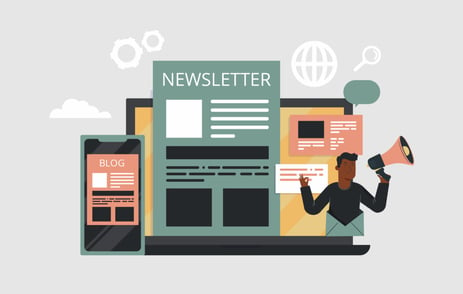Let’s pick up where we left off by discussing the tools and techniques of AI-generated tagging. As AI-generated tagging gains traction, it's not just about understanding its potential but also about harnessing it effectively. The right tools can streamline the tagging process, enhance accuracy, and provide insights that were previously out of reach. While the previous articles in this series introduced the concept of AI-generated tagging and its benefits, this post helps us transition to the practical side of things. We'll explore the tools available, from commercial platforms to open-source solutions, and guide you in selecting the best fit for your association's unique needs.
Defining the Methods of AI-Generated Tagging
At a high level, AI tagging tools can be bucketed into two main categories: commercial platforms and open-source solutions. Think of commercial platforms like an all-in-one resort. They come with a price tag but offer a polished experience, often with customer support and regular updates. On the flip side, open-source solutions are like Airbnb. They might require a bit more elbow grease but offer flexibility. Another plus of open-source solutions is that many of them are totally free.
But remember, the important part is finding the option that aligns with your association's goals, budget, and technical expertise. So, buckle up! We're about to embark on a journey through the exciting world of AI tagging tools, helping you make an informed choice for your association.
Option 1: Commercial Platforms
When it comes to commercial platforms for AI tagging, there's a lot to consider. These platforms often come as comprehensive packages, designed to offer a seamless experience right out of the box. They're tailored for those who prefer a more hands-off approach, where much of the technical heavy lifting is handled behind the scenes.
First, there's the advantage of user-friendliness. Many of these platforms come with intuitive interfaces, making them easy to use, even for those of us who aren’t too tech savvy. You get dashboards, analytics, and visual tools that simplify the tagging process.
Then there's the support aspect. Opting for a commercial platform often means you have a dedicated team just a call or email away, ready to assist with any hiccups and answer questions. This can be valuable when you're just starting out and might hit a few roadblocks along the way.
However, it's not all sunshine and rainbows. One of the primary considerations is cost. Commercial platforms come with varying price tags, often based on the volume of content, features, or the level of support provided. It's essential to weigh the benefits against the investment to ensure it aligns with your association's budget.
Another thing to keep in mind is the customization aspect. While these platforms are designed to cater to a broad audience, there might be specific needs unique to your association that aren't immediately met. Before moving forward, it’s worth checking how flexible the platform is in terms of integrations and custom developments.
Option 2: Open-Source Solutions
Open-source solutions are the unsung heroes in the tech world. They're the result of passionate communities coming together, pooling their expertise, and creating tools that are freely available for anyone to use and modify. When it comes to AI tagging, the open-source community has been particularly active, offering a range of tools that can rival even the most polished commercial platforms.
The beauty of open source lies in its flexibility. Since you have access to the underlying code, you can tweak and tailor the tool to fit your association's specific needs. This adaptability can be a game-changer, especially if you have unique requirements that aren't met by off-the-shelf solutions.
Another significant advantage is cost. Most open-source tools are free to use. Of course, there might be expenses related to hosting, maintenance, or if you decide to hire experts for customization. But the initial investment is often much lower than commercial platforms.
Conversely, diving into open source does come with its challenges. For one, you might need a certain level of technical expertise in-house, or you might need to collaborate with external developers who have expertise in your industry. Elastik Teams is a great option for the latter, offering outsourced technical resources with a team of developers who have deep knowledge of the association space. While there's a vast community ready to help, you won't have the dedicated support that comes with commercial platforms.
Another consideration is the learning curve. Some open-source tools can be complex, requiring time and effort to get up to speed. It's essential to factor in the time for training and familiarization.
What Is Natural Language Processing (NLP)?
At the heart of AI-generated tagging lies a fascinating domain of artificial intelligence known as Natural Language Processing, or NLP for short. If AI tagging tools are the engines driving our content organization, then NLP is the fuel that powers these engines.
NLP is all about enabling machines to understand, interpret, and generate human language. It's the reason why your virtual assistant can understand your voice commands or why your email can suggest auto-responses. In the context of AI tagging, NLP is the magic that allows tools to read through content, grasp its essence, and assign relevant tags.
So, how does this work? Imagine feeding an article about "sustainable farming practices" into an AI tagging tool. An NLP engine would scan the content, identify key themes and concepts like "organic crops," "water conservation," and "soil health," and then generate tags based on these insights.
But it's not just about understanding content. Modern NLP engines, especially those built on large language models, can recognize context, nuances, and even emotions in the text. This means the tags generated are deeply tied to the core message and intent of the content.
Now, you might wonder about the practicality of it all. The good news is that many AI tagging tools, both commercial and open-source, come with built-in NLP capabilities. This means you don't have to be an NLP expert to benefit from it. However, having a basic understanding can help you choose the right tool and optimize its performance. Essentially, NLP is the bridge between raw content and meaningful tags.
The Roadmap to Practically Applying AI-Generated Tagging
Embarking on the journey of implementing AI tagging can seem daunting, but with a clear roadmap, the process becomes much more manageable. Let's walk through the steps to get you started on integrating AI-generated tagging into your association's content management system.
1. Assess Your Needs: Before diving into any tool or platform, take a moment to understand your association's specific needs. Are you looking to categorize a vast archive of past articles? Or perhaps you want real-time tagging for new content? Your goals will guide your tool selection and implementation strategy.
2. Choose the Right Tool: As we've discussed, there are a ton of tools out there, from commercial platforms to open-source solutions. Based on your budget, technical expertise, and specific requirements, pick a tool that aligns best with your association's goals.
3. Integration: Once you've chosen a tool, the next step is integration. This would involve connecting the AI tagging tool to your content management system or website. Some tools offer plug-and-play solutions, while others might require a bit of coding. Ensure you have the right technical support during this phase.
4. Training the AI Model: AI is a learning machine. The more data it gets, the better it performs. Initially, you might need to feed it a batch of content and manually review the tags it generates. This “training phase” helps the AI understand the nuances of your content and refine its tagging accuracy.
5. Refinement: After the initial training, you’ll want to monitor the AI's performance. Are the tags relevant? Is there any consistent oversight? Based on these observations, you can tweak the tool's settings or provide more training data to enhance accuracy.
6. Continuous Monitoring and Improvement: AI tagging isn't a one-time setup. As your content evolves and grows, the AI tool will need periodic reviews and adjustments. Regularly check its performance, gather feedback from users, and make necessary refinements.
7. Feedback Loop: Consider setting up a feedback mechanism where users can suggest or edit tags. This not only improves tag accuracy but also provides valuable data to further train and refine the AI model.
Let’s Wrap It Up
In conclusion, implementing AI-generated tagging is a dynamic process that involves careful planning, execution, and continuous improvement. But with the right approach and tools, it can revolutionize how your association manages and organizes content, offering unparalleled efficiency and precision.
Don’t worry, later we'll be diving deeper into some of the leading AI-generated tagging platforms to explore their features, benefits, and potential use cases. You’ll walk away with a clearer picture of what’s on offer to make your decision. We look forward to guiding you further into the set-up process of AI-generated tagging to ultimately transform the way your association manages content. See you next time!
Tags:
Artificial Intelligence
September 12, 2023


